


Lore of a Legend: Browning A-5 Light Twelve
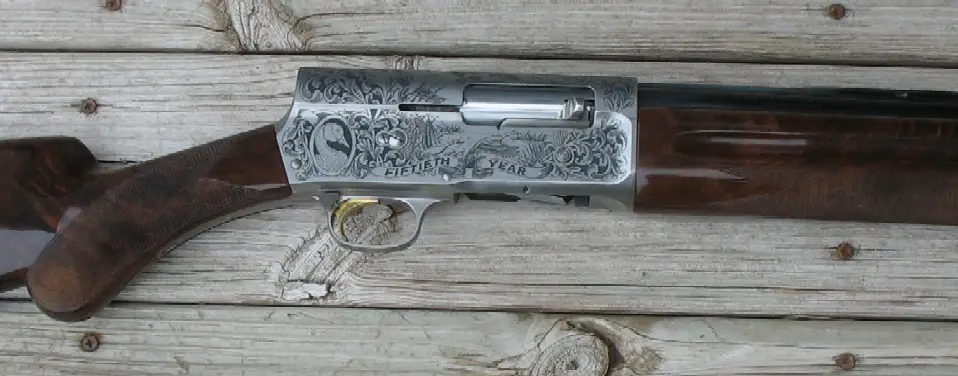
Above, is an essentially new in the grease Browning A-5 Light Twelve, the 1987 “Ducks Unlimited” 50 Year Anniversary edition. Made in Japan by Miroku, this version is one of the most traditional A-5 renditions: 2-3/4 inch chamber, 28 inch vent rib fixed modified choke barrel. The DU version has dramatically upgraded wood, and a French Gray receiver engraved in Japan, signed by the artist. The engraver of this A-5 was T. Nomura.
By the time the Automatic-Five made it to Japan around 1976 after 2,750,000 or so produced in Belgium, it became anything but light. This example is no exception, weighing in at a beefy eight and three-quarters pounds. Belgian A-5's have metric length barrels, so a “28 inch” barrel was more like 27-1/2 inches muzzle to breech and so forth. The forearm went through at least three different variations, each time adding more wood, strength, and weight. This shotgun was produced in 1987, albeit with stronger, steel-shot compatible steel than the Belgian models. The extra metal, wood, barrel length, ventilated rib now standard, and so forth all contributed to the A-5's substantial, but surprisingly well-balanced mass at this stage of manufacture. As you might gather, the lighter A-5's twelve gauges were the 25-1/2 inch plain-barreled Belgian Light Twelves. The same holds true for the plumping up of later Miroku-made 20 and 16 gauge models, with both 26 inch vent rib standard Invector examples that I own edging 7-1/2 pounds.
The trigger on this A-5 DU breaks at a very crisp 4-1/4 pounds, an excellent trigger as is the case with most A-5's. It has the two-piece shell carrier (speed-loading) and the familiar magazine cut-off on the left side of the receiver. The DU model is the only A-5 Light twelve to come with a solid rubber buttplate as opposed to the original horn, later black plastic buttplates.
It is hard to write about the A-5 without having some sense of history. What can you say about a firearm designed in 1898 that launched a gun company and not only was the first successful autoloading shotgun, but had no serious competition for over fifty years? In 1898, Hawaii was annexed, the U.S.S. Maine exploded, and Teddy Roosevelt was elected governor of New York. A year after the A-5 was patented, Ford Motor Company built its first car, the Model A. It wasn't until 1907 that Oklahoma became the 46th state. The Titanic sunk in 1912 and in 1913 the 16th Amendment to the Constitution was passed, giving the Federal government the right to tax. The A-5 was invented fifteen years before income tax. I'm of the opinion that the A-5 was the far better idea.
I can't shake the feeling that despite its unprecedented run, the A-5 was never given the benefit of the latest materials and production techniques. In large measure, it wasn't. The shift from Belgian to Japanese production didn't result in a greatly advanced application of materials. It did give the A-5 screw-chokes, steel-shot capability, but it also resulted in what the A-5 needed the very least of all: weight gain. That's never been more prominent than in this beefy Miroku example. The last thing most folks want to carry around chasing pheasants is a 2-3/4 inch only chambered 12 gauge that, fully loaded, is about a 9 pounder. That's what the A-5 “Light Twelve” ultimately became, though, and despite its other attributes the weight is hard to get past for many applications. The majority of new consumers didn't and that was death toll for the Automatic-Five.
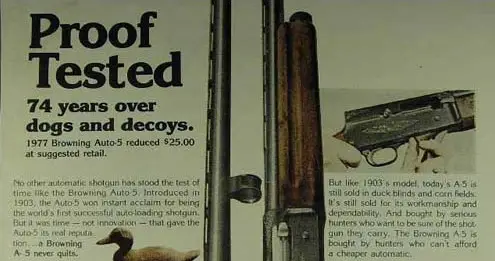
1977 brought the cost of the A-5 down a bit. Unfortunately, it brought the price per pound down far more. While not immediately the kiss of death, it was at least the kiss of Kirstie Alley.
Conspiracy theorists like to insist that Browning has a role in ending the A-5's production, but there is little basis for that. It has also been called “too expensive to make,” but that isn't precisely true, either. The Browning A-5 was never a bargain-basement or inexpensive shotgun; it was always an upscale shotgun. It was positioned as an upscale, premium shotgun and maintained that posture throughout it's production in large measure. Cost was removed from its production by less and less handwork as the years went by. Handfitting of the barrels was no longer needed once manufacturing tolerances improved to the point of interchangeable barrels. With its move to Japanese production, hand-checkering gave way to “machine checkering by hand” and then cut-checkering. Rust bluing became hot salt, and Miroku efficiency lowered costs just like it had done for the Citori. Unlike the Citori, though, the A-5's orders steadily shrunk until the minimum production runs were no longer sustainable.
The A-5 was versatile from the beginning, but not in the way many people think of versatility today. One of the oldest 12 gauge propellants is Alliant Red Dot, introduced in 1932. By the time of Red Dot's introduction, the A-5 had already been running for over three decades with a variety of crude propellants and shotshells, at least by today's standards. Though versatile in its 2-3/4 inch chambering, the notion of the 3-1/2 inch 12 gauge shell wasn't something that a long recoil action could easily be extended to. The short recoil action was far better suited as Benelli has vividly shown, but Browning's flub of the A500/A500R kept the A-5 prominent until the Browning Gold of 1994 proved competent enough to seal the eventual fate of the A-5.
The A-5 did have a little intra-action competition, long after the Browning patents expired. The Remington 11-48 was a more modernistic version of the A-5, and a cheaper one. With stamped parts and an aluminum trigger guard, it was less costly to make and was available in a wide variety of gauges, including the 28 gauge and .410 bore. Considered a successful model, its tenure was cut short by the only autoloader to unseat the A-5 in the sales department, the Remington 1100.
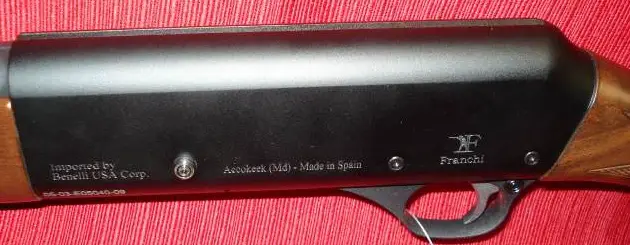
Cheaper, lighter, less durable: the Franchi AL-48 borrowed the A-5's long-recoil action, lost a lot of weight, but lost strength and build quality as well.
At the same time, the Franchi AL-48 appeared, a Spanish-made, cheaper, lighter, alloy impression of the A-5. As it happens, Browning both considered and produced an alloy version of the A-5 as well. Browning reportedly felt that American hunters were a lot harder on their equipment than many European enthusiasts and the far plainer, weaker, generally undesirable alloy A-5 was never released in the United States in any great quantity. Though production of the AL-48 in 12 gauge has been discontinued, the 20 and 28 gauge models are still hanging on at the moment, if only by a thread. Like the Remington 11-48, it is often considered another inferior, cheap version of the A-5. The AL-48 lacks the speed-loading, magazine cut-off, and build quality of the A-5. Whenever you have a steel barrel reciprocating inside a soft alloy receiver, the steel eventually wins the day. Nevertheless, the AL-48 is light and in both 20 and 28 gauge forms it ranks as one of the longest-running, truly under six pound autoloaders out there. Also sometimes listed and cited as the 48 AL, it is the same shotgun.
To be fair to the Franchi Model 48, it was and is at a lower price-point. While comparatively fragile to the A-5, many hunters don't shoot all that much. I know more than a couple of folks that just plain like the 2-3/4 in. AL-48 in 20 gauge, finding that 7/8 oz. loads do the trick for a little casual clay-busting, and a 1 oz. load of #7-1/2 shot is ideal for quail with and open choke, the same load in #6 fine for preserve pheasants or early season pheasants in general. We all like what we like and the notion of durability is always subjective. Good enough is often just that.
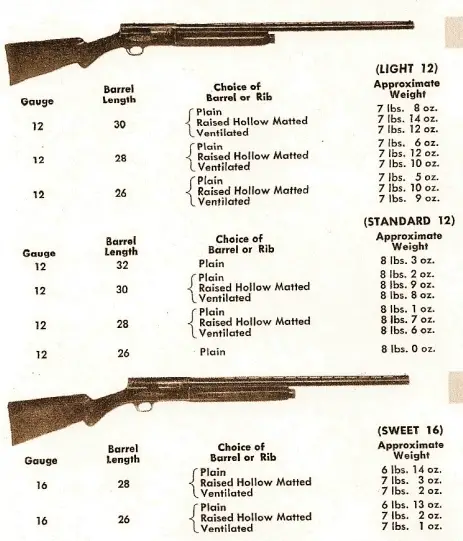
The overweight Miroku-made A-5 "Light Twelve" Ducks Unlimited at 8-3/4 lbs. is in no way light, actually significantly heavier than vintage "Standardweight" A-5 models. The shift to Japanese production lowered per unit costs, added steel-shot capability and eventually screw-chokes, all the while packing on the calories. By not thinking things through, the A-5 became the "Rosie O'Donnell of the Uplands."
The notion of the A-5 getting short-shrift in the development process is based on weight and handling. The Belgian 26 inch plain-barreled (matted rib in the A-5, meaning chicken-scratching on the top of the barrel but no rib) versions were light, fast, and made more hunting sense than the later models. The “Belgian 26” was 25-1/2 inches, losing the rib lost a lot of needless weight. With the generous, squared-off receiver no vent rib was ever necessary. As the rib is never so much as seen or referred to in a hunting situation, its existence has little merit. I suppose we think it “looks cool” but to look cool we have unwanted weight and little more than a gathering place for dust and dirt. Not necessarily the case overseas, you'll find Beretta Models noted as “Senza Rib,” meaning without rib. It accomplishes the same goal of losing unwanted weight from the barrel.

The Beretta 391 "Senza Rib" model: an approach abandoned by Browning.
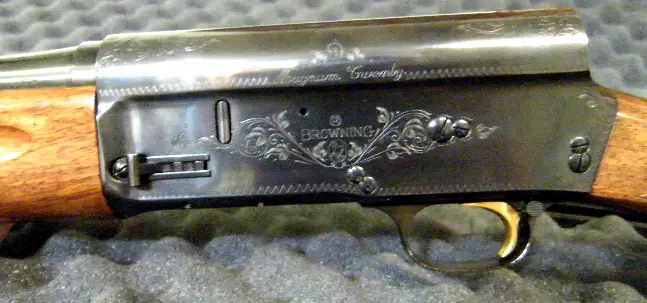
This 1971 plain-barreled A-5 20 Mag hits the scales at a satisfying 6-1/2 pounds, a weight never again approached with Japanese production Auto-Fives.
So, there is a bit of a melancholy reaction to the final treatments of the A-5. Still great in the duck blind, fun on the dove field, and perhaps a bit more adept at skeet and sporting clays than the Belgian production, the Japanese renditions could have been far better in the field. The once 7-1/4 plus Light Twelve soared to 8-1/2 pounds plus in is later years, with A-5 12 Mags popping the 9 pound barrier without much trouble. While its function was never compromised, nor was its strength, merely maintaining classic weight levels would have also maintained its classic versatility and desirability. Hindsight is a wonderful thing, of course, and retooling costs are hefty. If a fraction of the resources thrown at the B-2000 and the A500 / A500R were instead directed at refreshing the A-5, it would be vibrantly alive and well today.
The
A-5's shell-handling has never been bettered, no autoloader has been better
built and has actually lasted the number of lifetimes of hunting that
the A-5 already has. Fortunately, it wasn't exactly a limited run, so
for those who appreciate them, they need not go without. I don't believe
I ever will.
Copyright 2010 by Randy Wakeman. All Rights Reserved.

Custom Search



